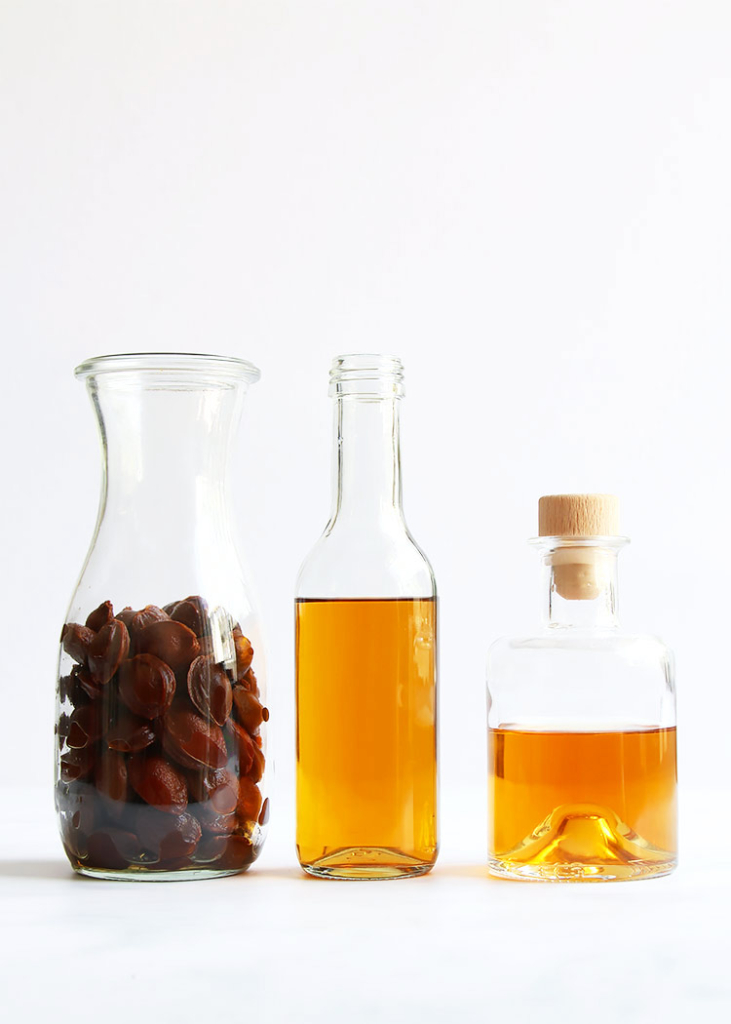
Homemade amaretto liqueur made with only 3 ingredients: apricot pits, vodka, and sugar. It’s a quick and fuss-free recipe for amaretto: Let the pits steep in vodka, add sugar and that’s it.
The addictive marzipan-almond flavored liqueur is perfect to drizzle over ice cream, to add to desserts, cakes, cookies, and pancakes, or to drink as a digestif – I’m sure you’ll love it. This DIY amaretto makes a great gift too.
No-waste recipe
Last summer, I made a looooot of apricot jam to find the perfect recipe for my cookbook. Hence, I had a lot of apricot pits that I would usually toss. But then, I love repurposing ingredients that are otherwise discarded, like watermelon rind pickles or apricot pits. So I was tempted to try this homemade amaretto. And guess what? It tastes so good, that I would actually recommend making some apricot jam just for the sake of getting the pits.
Oh, and by the way: You could use pits from other stone fruit to make amaretto too, like plum pits or cherry pits. The taste may vary slightly but the outcome will be a delicious liqueur as well.
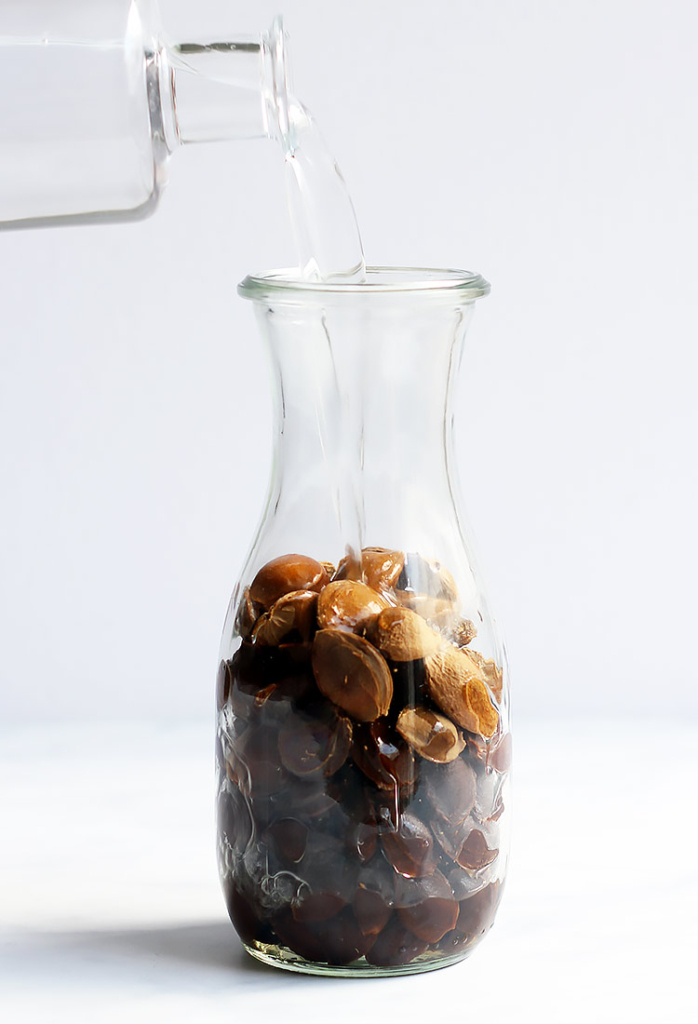
Advantages of homemade amaretto
You can tailor homemade amaretto perfectly to your preference. You love Amaretto with a hint of vanilla? Add a vanilla bean. Is the flavor too intense for you? ‚Thin‘ it with a little more vodka. You don’t like it overly sweet? Reduce the sugar. The biggest advantage of the homemade version is probably that you know exactly how much sugar goes in. There is no artificial color needed, nor are preservatives.
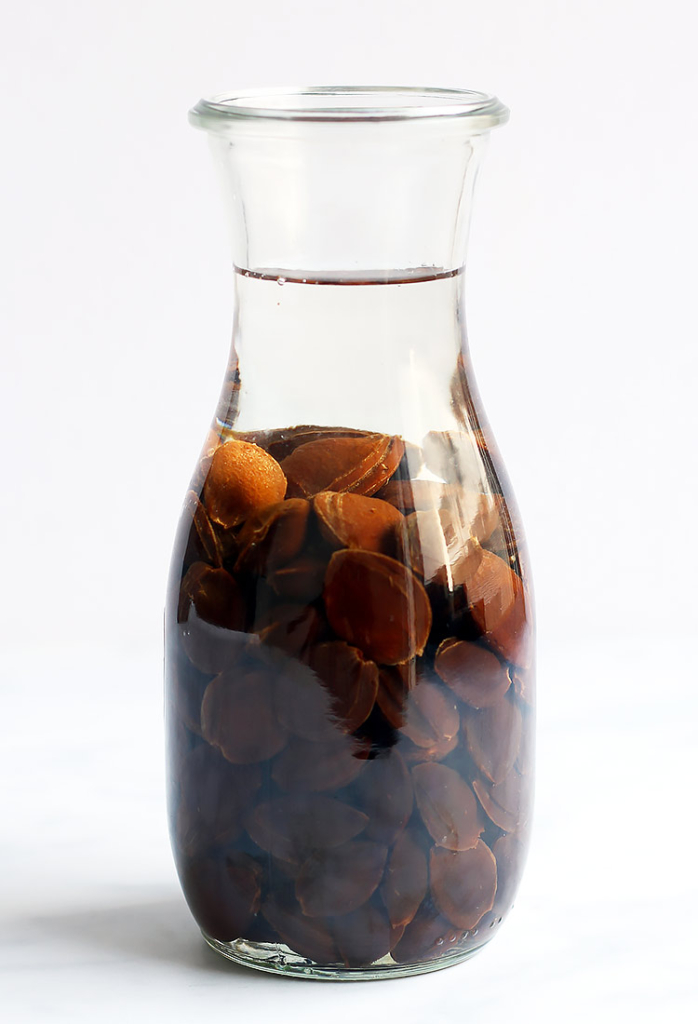
Apricot pits in vodka. Now, it is time to wait.
What is Amaretto?
Amaretto is an almond-flavored liqueur, which hails from Italy. The word amaro means bitter in Italian, amaretto means a little bitter. The subtle bitterness refers to the distinctive flavor derived from bitter almonds the liqueur was originally made from. Modern versions use regular almonds or drupe stone like apricot pits to imitate that distinctive flavor. Often times knock-offs (‚creme de almond‘) are made from extracts or almond oil.
However, the liqueur tastes somehow like marzipan and is rather sweet than bitter due to the added sugar. That is why Amaretto is a popular drink on its own, especially as an after dinner drink. It is a great mixer as well. Amaretto usually has an alcohol content of around 25 %.
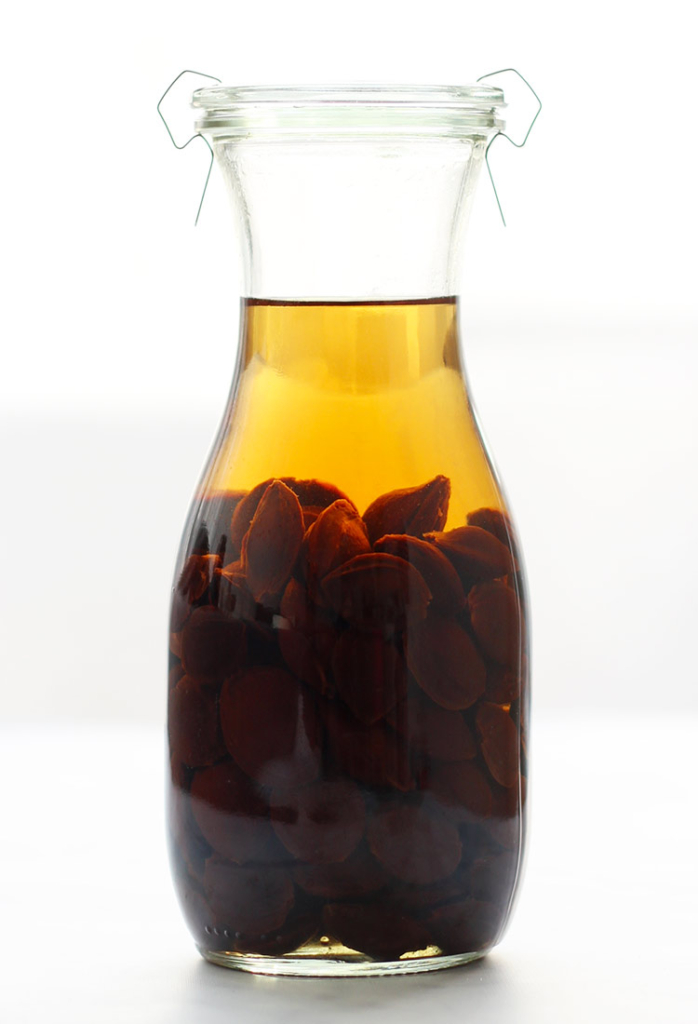
The color will gradually darken. Picture: after about 1 month of steeping.
How to make homemade amaretto?
When making apricot jam or a cake, I collect the pits instead of tossing them. I put the pits in a sealable jar and let them steep in vodka for 2 months. The alcohol will gradually darken to an amber color and intensify its flavor. After steeping, I strain the pits and add a little sugar. Done.
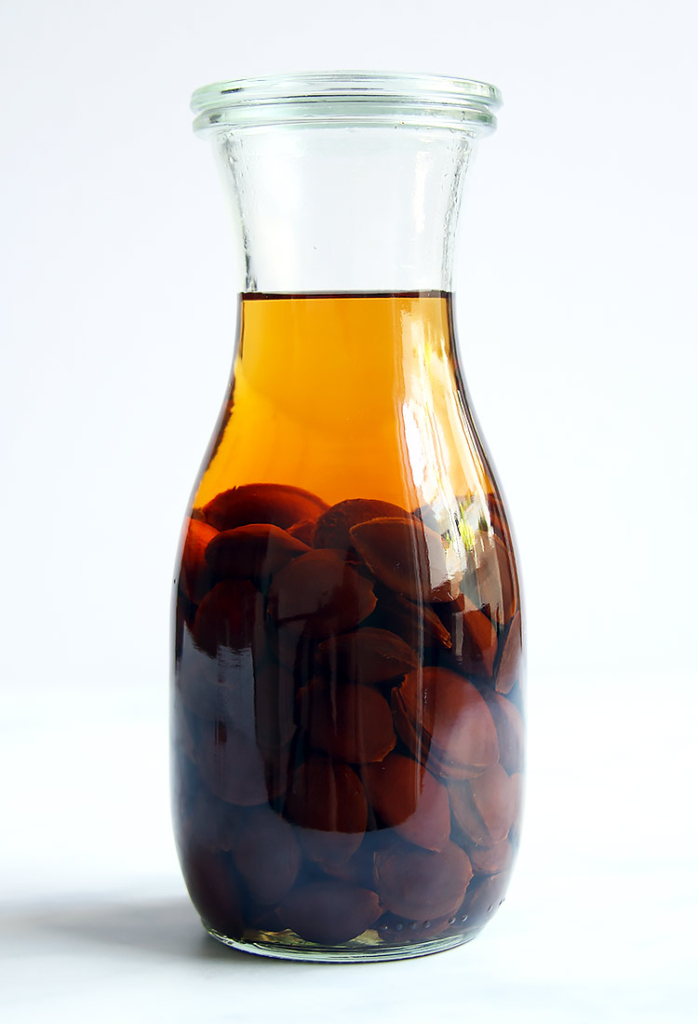
After 2 months of steeping, the vodka will have an amber color.
How to prepare apricot pits for liqueur
In short: Wash the pits, dry them, and use them.
The long version: First of all, collect the apricot pits. You will need roughly 4-6 lb (2-3 kg) of small apricots to get 1 1/4 to 1 1/2 cups of pits. This depends largely on the kind of apricots – some have smaller stones, some varieties have larger ones. If I don’t make apricot jam, which requires a large amount of apricots, I usually collect the pits over weeks to get the amount needed.
After pitting the apricots, I will run them under water and rub off any fruit parts, since those can get moldy. You can use a vegetable brush or a sponge, but I usually just scrub them clean with my hands. This takes a matter of seconds per pit.
After cleaning the stones, I let them dry on a paper towel. If you have enough pits already, you can make the amaretto now. If not, collect some more pits. In the meantime, I transfer the dry pits from the paper towel to a small plate and cover them with a cloth – a light tea towel or even paper towels work fine. I do this to protect them from dust and to keep them airy. This way, I collect more and more pits over the following weeks. As soon as I have enough, I start making the amaretto.
I am using apricot pits as a whole for this recipe. No need to crack them open to get the kernel inside.
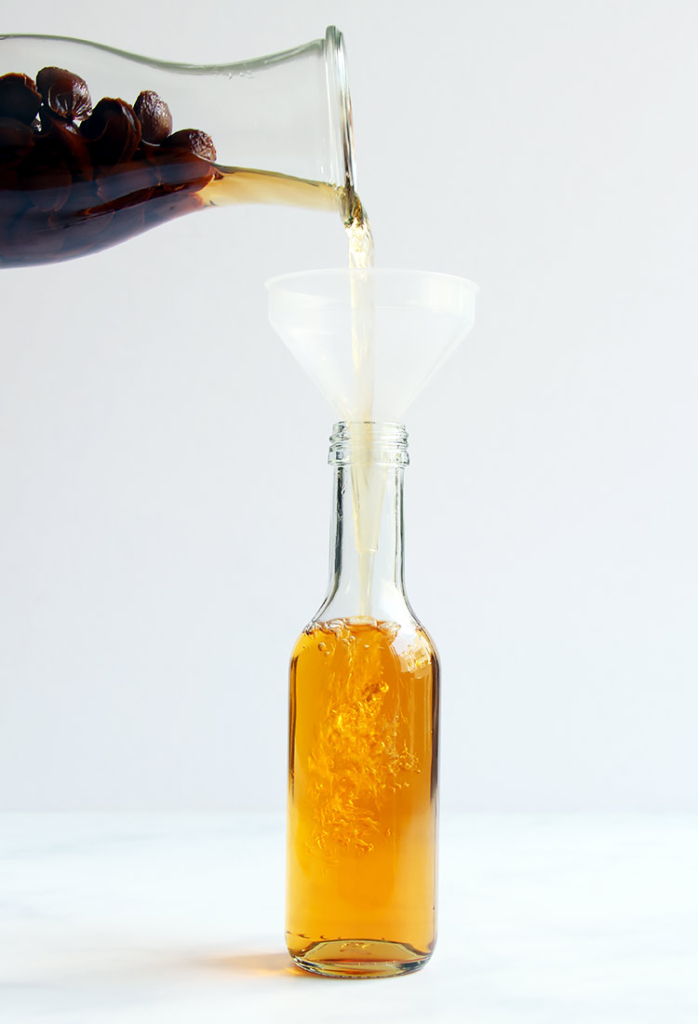
After 2 months, the homemade amaretto is ready.
Are apricot kernels poisonous?
Many traditional liqueurs like amaretto are made with stone fruit kernels. These recipes often date back hundreds of years, especially in Europe.
But: Stone fruit kernels, which you can find within the wooden pits of apricots, nectarines, peaches, cherries, bitter almonds (yes, this is a stone fruit as well), and plums contain small amounts of amygdalin. Amygdalin is a precursor to cyanide. Even apple seeds contain amygdalin. That’s why I am using whole apricot pits and not the kernels inside. I do not crack them open since this releases more amygdalin.
Our body can deal with small amounts of amygdalin but a high dose could be poisonous. Therefore, you have to decide for yourself if you consider making and drinking this amaretto is safe enough for you. If you are planning on drinking it on its own, I’d recommend you enjoy it within reason and do not get wasted on this liqueur. As we all know: The dose makes the poison.
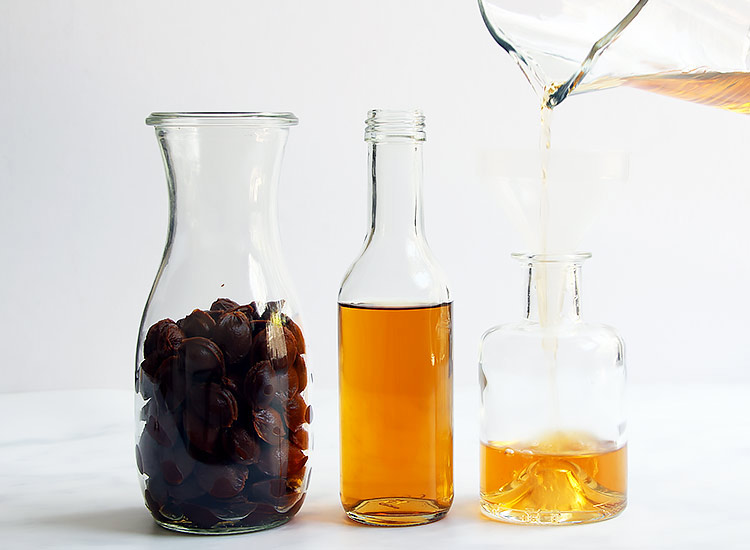
Strain off the pits, then strain alcohol through a cheescloth, and bottle.
How to use amaretto?
- Drizzle it over ice cream
- Add it to desserts (think tiramisu), creams, and frostings
- Add it to cake and cookie batters (like these amaretti cookies), waffle or pancake batters as an alternative to vanilla or almond extract
- Sip it on its own as a digestif (dessert drink) after dinner
- Make a boozy gift for someone special
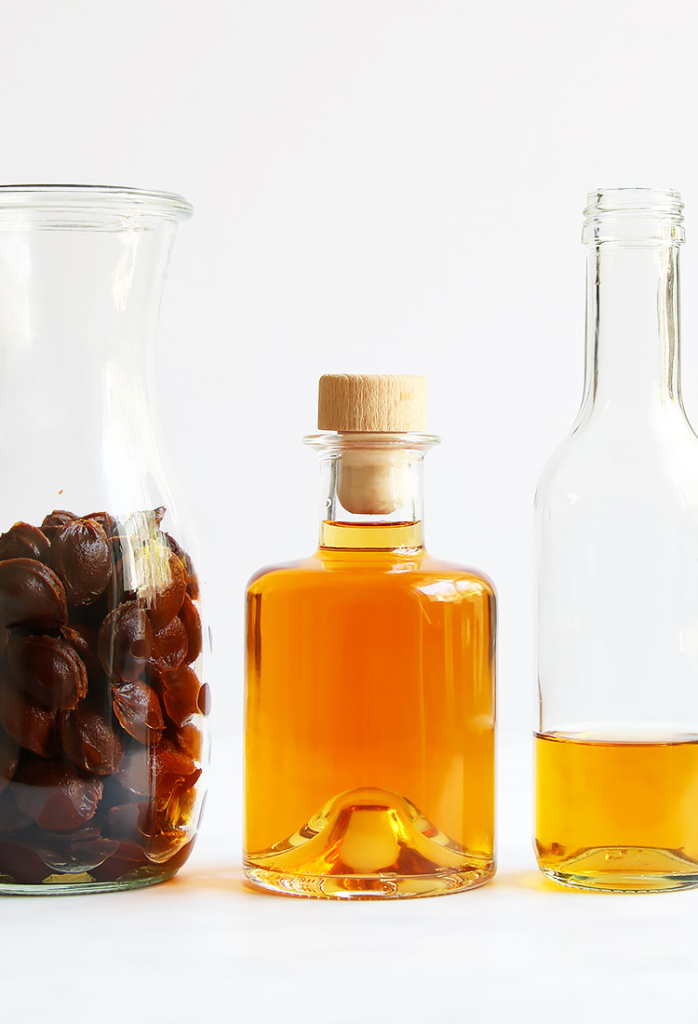
The finished homemade amaretto liqueur will look like this :-)
Have fun!
Homemade amaretto liqueur made with 3 ingredients: apricot pits, vodka, and sugar. The addictive marzipan-almond flavored liqueur is perfect to drizzle over ice cream or to add to desserts (tiramisu). It tastes great in cakes and cookies, pancakes, and waffles. Or drink it on its own as an after dinner drink. This amaretto also makes a great boozy gift.
Recipe: Ursula | lilvienna.com
Ingredients
- 1 1/4 to 1 1/2 cups (170 g) clean and dry apricot pits (see note)
- 1 2/3 cups (400 ml) vodka, 40 % alcohol (= 80 proof)
- 3 tablespoons (40 g) fine granulated sugar
Instructions
- Place the apricot pits in a large sealable glass jar or bottle, holding 2 cups /500 ml or larger.
- Pour the vodka in and seal the jar.
- Let the pits steep for 2 months. (I let them steep in my bookshelf in the living room.) The vodka will turn dark amber.
- Strain out the pits through a strainer. Filter the strained liquid through a multi-layered cheesecloth into a pitcher to remove fine sediment. This will make the finished liqueur even clearer.
- Add the sugar and stir until dissolved, a few minutes. Taste it and adjust the sugar if it is not sweet enough for you. If the almond-flavor is too intense for your taste, add more vodka to ‚thin‘ it, or alternatively use it as almond extract. Be aware that it will get milder and smoother over time.
- Bottle the amaretto. It will keep at least a year but usually longer.
Notes
How to prepare apricot pits for liqueur:
You will need roughly 4-6 lb (2-3 kg) of small apricots to get 1 1/4 to 1 1/2 cups (300-360 ml) of pits. The amount needed largely depends on the kind of apricots – some have smaller stones, some varieties have larger ones. Go and make some apricot jam :-)
After pitting the apricots, rinse them with water and rub off any fruit parts with your fingers, a brush, or a sponge. Let them dry on a paper towel. If you have enough pits already, you can make the amaretto right away. If not, collect some more pits. In the meantime, transfer the dry pits from the paper towel to a small plate and cover them with a cloth – a light tea towel or even paper towels work fine - to protect them from dust and to keep them airy. Collect more pits over the weeks. As soon as you have enough, make the amaretto.
I am using whole apricot pits including the hard, wooden shell for this recipe. Do not to crack them open to use the kernel inside (note that kernels contain amygdalin, see safety notes in the article above).

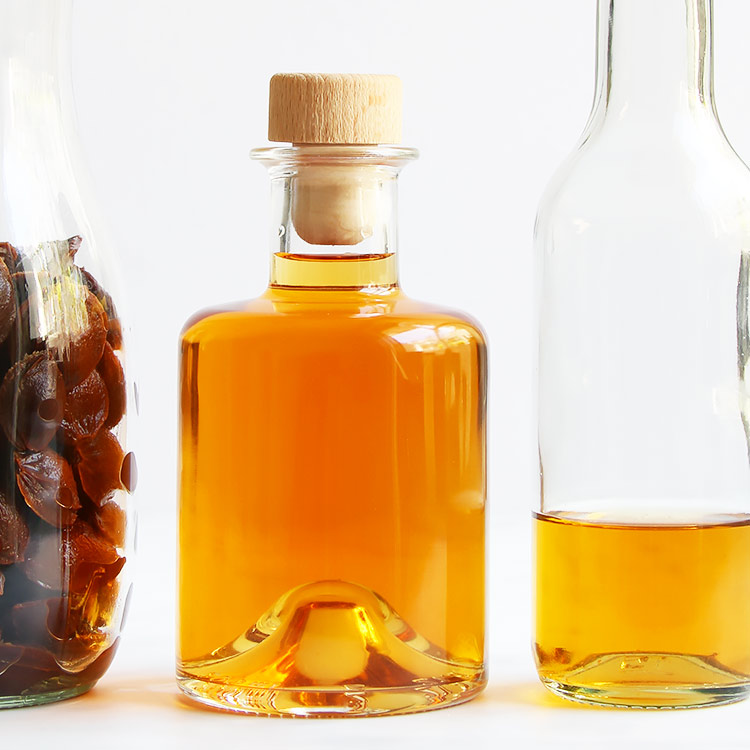

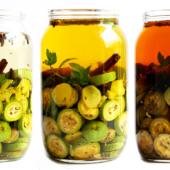

Hello, Ursula!
Thank you so much for such a great recipe! I really like that you use apricot pits instant of almond extract.
Would you be so kind as to prompt me, please, how long is the shelf life after it is completed, and does it need refrigerating?
Many thanks in advance.
All the best.
Mira
Hi Mira,
The homemade apricot liqueur will keep a year for sure. Actually, I believe it keeps indefinitely or at least a very long time ;-) My bottles from the previous years that I had made are still good – stored at room temperature. After all, it’s just alcohol and sugar. No need to refrigerate. Best, Ursula
Hello, Ursula!
Thanks a lot for your reply!
God bless you and your family!
Wish you all the best.
Mira
Can you use peach pits because where I live I can’t find apricot anywhere
Hi Dawn,
I’ve never made it with peach pits because I don’t buy lots of them for making jam or whatever. But I’ve seen people making the liqueur with peach pits. You might want to find peaches, where the fruit doesn’t annoyingly stick to the pit though since you have to clean it from fruit pieces. Also, you can freeze them or dry them until you got the amount needed. Plum pits work well too! Best, Ursula
Hi Ursula,
Thank you for this amazing recipe. I am wondering if this recipe could also be done with 95% alcohol instead of 40% regular vodka. I have recently made limoncello with 95% alcohol and so I still have some left.
Thanks in advance for your answer.
Kind regards,
Jonathan
Hi Jonathan,
I have never tried it with 95% but I’d say it is quite agressive for that purpose. Also, you would have to delute it before you could drink it. For limoncello, the 95% is fine since you add syrup (sugar-water) later in the process, which is not the case here. So I’d make another batch of limoncello (or orange peel) with the 95% and stick to around 40% for this recipe. Hope you’ll try it some day! Ursula
will the extract be safe to use if the apricot kernels have been soaking for over a year?
Hi Amy,
I have personally used kernels that have been soaking for almost a year (if I remember correctly)… it tasted awesome and very intense :-) But of course I can not recommend it in general – so it is up to you. I use the homemade amaretto liqueur mostly for baking (amaretti, tiramisu, cake batter). I love it!
Ursula
Hi Ursula, I still have some apricot pits from last summer, can I still use them? They are dried out I suppose, but would they still be good?
Hi Patricia,
I guess so! They will be dried out and therefore soak up some of the alcohol. So don’t be surprised if you get out less amaretto than you put alcohol in :) I love to use the homemade apricot liqueur for baking. I often add a teaspoon or two to cake batters or Tiramisu. Tastes wonderful! Ursula
Just fyi: You can purchase cyanide test strips on amazon, like this one, https://a.co/d/3DNuniN, to make sure the alcohol is safe to consume.
It tastes horrible. I used high quality vodka, but the result is undrinkable, horribly bitter and nasty. I followed the instructions, but the result is awful.
Hi Ellis island,
I have made this Amaretto so often and it turend out well every single time. So far, you are the first person with negative feedback. Usually, everybody is so happy with the result. I honestly can’t explain why it tastes so bitter. It should taste a tad bitter, but not too much. You could try adding a bit more sugar, since the amount of sugar given in the recipe is rather low. But if it still tastes bitter, there is definitely something not right with the result. So sorry that happened to you :( Ursulae